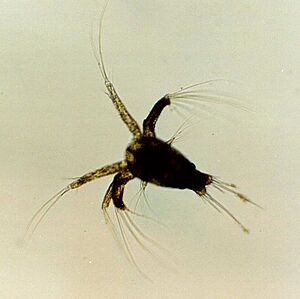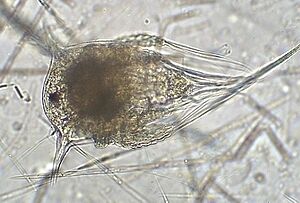Nauplius facts for kids


A nauplius (say "NAW-plee-us") is the very first baby form of most crustacea. Think of it like the first tiny stage of a butterfly before it becomes a caterpillar or chrysalis! This tiny creature hatches from an egg. It's often followed by other baby stages before the animal grows into its adult shape. For some animals, there can be many different baby stages, sometimes as many as nine! Sometimes, the nauplius stage even happens inside the egg, and a later baby stage hatches out instead.
Contents
What is a Nauplius?
A nauplius is a special type of larva. A larva is a young form of an animal that looks very different from its parents. For example, a caterpillar is the larva of a butterfly. The nauplius is the first larval stage for most crustaceans. Crustaceans are a group of animals that include crabs, lobsters, shrimp, and barnacles.
Tiny and Simple
Nauplii are usually very small, often too tiny to see without a microscope. They have a simple body plan. They typically have three pairs of legs that they use for swimming and for gathering food. They also have a single eye, called a "naupliar eye," right in the middle of their head. This eye can sense light and help them find their way.
Where Do They Live?
Most nauplii live in the ocean or in fresh water. They float around in the water as part of the plankton. Plankton are tiny organisms that drift with the currents. Being part of the plankton means they can travel to new places. It also means they are a food source for other small animals.
The Nauplius Life Cycle
The nauplius stage is a very important part of a crustacean's life cycle. It's the beginning of their journey from egg to adult.
From Egg to Larva
A female crustacean lays many tiny eggs. Inside these eggs, the nauplius starts to grow. Once it's ready, it hatches out into the water. At this stage, it's very vulnerable. It needs to find food and avoid being eaten by predators.
Growing Up: Molting
As a nauplius grows, its hard outer shell, called an exoskeleton, doesn't grow with it. So, to get bigger, the nauplius has to shed its old shell. This process is called molting. After molting, the nauplius has a new, soft shell that can expand. It then grows quickly before its new shell hardens. This happens many times as the nauplius gets bigger.
Changing Forms: Metamorphosis
After several molts, the nauplius changes into a different larval stage. This big change is called metamorphosis. It's similar to how a tadpole changes into a frog. The next larval stage will look more like the adult crustacean, but it might still be very small and not fully developed. For some crustaceans, like barnacles, the nauplius changes into a different larval form called a cyprid larva.
Examples of Nauplii
Many different crustaceans have a nauplius stage.
Shrimp and Prawns
Shrimp and prawns are common crustaceans. Their life cycle starts with a nauplius. These tiny nauplii swim around, eating even smaller bits of food in the water. They will go through several more larval stages before they look like the shrimp you might see in an aquarium or at the store.
Barnacles
Barnacles are unique crustaceans that attach themselves to rocks or boats as adults. But they start their lives as free-swimming nauplii! The nauplius of a barnacle swims around for a while. Then, it changes into a cyprid larva, which is the stage that finds a place to stick down and grow into an adult barnacle.
Copepods
Copepods are tiny crustaceans found in almost every freshwater and saltwater habitat. They are a huge part of the ocean's plankton. Their life cycle also includes a nauplius stage. Copepod nauplii are incredibly important because they are a major food source for many other marine animals, including small fish.
Why are Nauplii Important?
Nauplii play a vital role in ocean ecosystems. They are a key link in the food chain. They eat tiny plants and other small particles in the water. In turn, they are eaten by larger animals. Without nauplii, many marine animals would not have enough food to survive. They are also important for the survival of crustacean species, ensuring new generations can grow and thrive.


